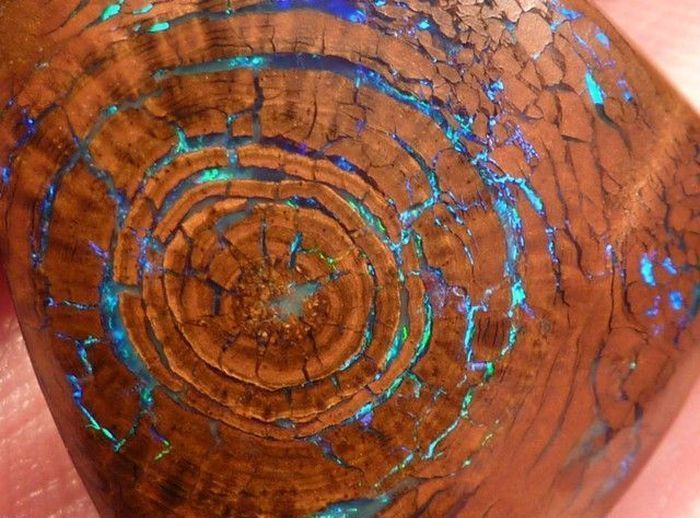|
|
Opalized Wood Boulder Opal
|
The town of Coober Pedy in South Australia is a major source of opal. The world's largest and most valuable gem opal "Olympic Australis" was found in August 1956 at the "Eight Mile" opal field in Coober Pedy. It weighs 17,000 carats (3450 grams) and is 11 inches (280 mm) long, with a height of 4 3⁄4 inches (120 mm) and a width of 4 1⁄2 inches (110 mm).
The Mintabie Opal Field located approximately 250 km north west of Coober Pedy has also produced large quantities of crystal opal and also the rarer black opal. Over the years it has been sold overseas incorrectly as Coober Pedy Opal. The black opal is said to be some of the best examples found in Australia.
Andamooka in South Australia is also a major producer of matrix opal, crystal opal, and black opal. Another Australian town, Lightning Ridge in New South Wales, is the main source of black opal, opal containing a predominantly dark background (dark-gray to blue-black displaying the play of color). Boulder opal consists of concretions and fracture fillings in a dark siliceous ironstone matrix. It is found sporadically in western Queensland, from Kynuna in the north, to Yowah and Koroit in the south. Its largest quantities are found around Jundah and Quilpie (known as the "home of the Boulder Opal") in South West Queensland. Australia also has opalised fossil remains, including dinosaur bones in New South Wales, and marine creatures in South Australia. The rarest type of Australian opal is "pipe" opal, closely related to boulder opal, which forms in sandstone with some iron-oxide content, usually as fossilized tree roots.
The Virgin Valley opal fields of Humboldt County in northern Nevada produce a wide variety of precious black, crystal, white, fire, and lemon opal. The black fire opal is the official gemstone of Nevada. Most of the precious opal is partial wood replacement. The precious opal is hosted and found within a subsurface horizon or zone of bentonite in-place which is considered a "lode" deposit. Opals which have weathered out of the in-place deposits are alluvial and considered placer deposits. Miocene age opalised teeth, bones, fish, and a snake head have been found. Some of the opal has high water content and may desiccate and crack when dried. The largest producing mines of Virgin Valley have been the famous Rainbow Ridge, Royal Peacock, Bonanza, Opal Queen, and WRT Stonetree/Black Beauty Mines. The largest unpolished Black Opal in the Smithsonian Institution, known as the "Roebling Opal," came out of the tunneled portion of the Rainbow Ridge Mine in 1917, and weighs 2,585 carats. The largest polished black opal in the Smithsonian Institution comes from the Royal Peacock opal mine in the Virgin Valley, weighing 160 carats, known as the "Black Peacock."
|
|









